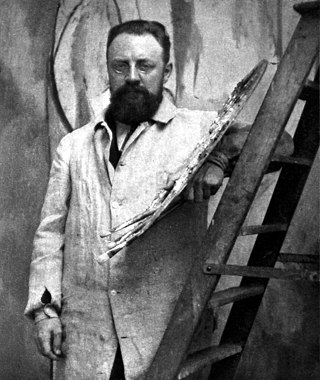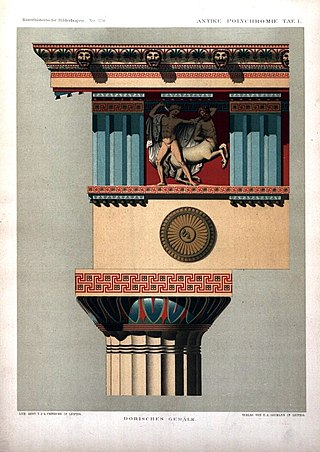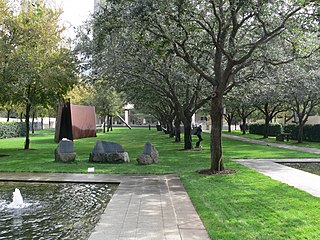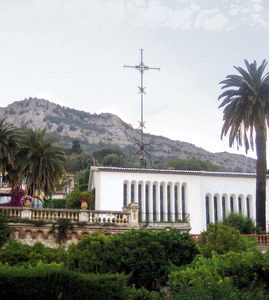
Henri Émile Benoît Matisse was a French visual artist, known for both his use of colour and his fluid and original draughtsmanship. He was a draughtsman, printmaker, and sculptor, but is known primarily as a painter. Matisse is commonly regarded, along with Pablo Picasso, as one of the artists who best helped to define the revolutionary developments in the visual arts throughout the opening decades of the twentieth century, responsible for significant developments in painting and sculpture.

Jeu de Paume is an arts centre for modern and postmodern photography and media. It is located in the north corner of the Tuileries Gardens next to the Place de la Concorde in Paris. In 2004, Galerie Nationale du Jeu de Paume, Centre national de la photographie and Patrimoine Photographique merged to form the Association Jeu de Paume.

The National Gallery of Art is an art museum in Washington, D.C., United States, located on the National Mall, between 3rd and 9th Streets, at Constitution Avenue NW. Open to the public and free of charge, the museum was privately established in 1937 for the American people by a joint resolution of the United States Congress. Andrew W. Mellon donated a substantial art collection and funds for construction. The core collection includes major works of art donated by Paul Mellon, Ailsa Mellon Bruce, Lessing J. Rosenwald, Samuel Henry Kress, Rush Harrison Kress, Peter Arrell Browne Widener, Joseph E. Widener, and Chester Dale. The Gallery's collection of paintings, drawings, prints, photographs, sculpture, medals, and decorative arts traces the development of Western art from the Middle Ages to the present, including the only painting by Leonardo da Vinci in the Americas and the largest mobile created by Alexander Calder.

The Texas State Capitol is the capitol and seat of government of the American state of Texas. Located in downtown Austin, Texas, the structure houses the offices and chambers of the Texas Legislature and of the Governor of Texas. Designed in 1881 by architect Elijah E. Myers, it was constructed from 1882 to 1888 under the direction of civil engineer Reuben Lindsay Walker. A $75 million underground extension was completed in 1993. The building was added to the National Register of Historic Places in 1970 and recognized as a National Historic Landmark in 1986.

Polychrome is the "practice of decorating architectural elements, sculpture, etc., in a variety of colors." The term is used to refer to certain styles of architecture, pottery, or sculpture in multiple colors.

Notre-Dame du Haut is a Roman Catholic chapel in Ronchamp, France. Built in 1955, it is one of the finest examples of the architecture of Franco-Swiss architect Le Corbusier. The chapel is a working religious building and is under the guardianship of the private foundation Association de l’Œuvre de Notre-Dame du Haut. It attracts 80,000 visitors each year. In 2016, it was inscribed on the UNESCO World Heritage List in along with sixteen other works by Le Corbusier, because of its importance to the development of modernist architecture.

The Dallas Museum of Art (DMA) is an art museum located in the Arts District of downtown Dallas, Texas, along Woodall Rodgers Freeway between St. Paul and Harwood. In the 1970s, the museum moved from its previous location in Fair Park to the Arts District. The new building was designed by Edward Larrabee Barnes and John MY Lee Associates, the 2007 winner of the American Institute of Architects Gold Medal. The construction of the building spanned in stages over a decade.

Opened in 2003, the Nasher Sculpture Center is a museum in Dallas, Texas, that houses the Patsy and Raymond Nasher collection of modern and contemporary sculpture. It is located on a 2.4-acre (9,700 m2) site adjacent to the Dallas Museum of Art in the Dallas Arts District.

Ellsworth Kelly was an American painter, sculptor, and printmaker associated with hard-edge painting, Color field painting and minimalism. His works demonstrate unassuming techniques emphasizing line, color and form, similar to the work of John McLaughlin and Kenneth Noland. Kelly often employed bright colors. He lived and worked in Spencertown, New York.

Contemporary architecture is the architecture of the 21st century. No single style is dominant. Contemporary architects work in several different styles, from postmodernism, high-tech architecture and new references and interpretations of traditional architecture to highly conceptual forms and designs, resembling sculpture on an enormous scale. Some of these styles and approaches make use of very advanced technology and modern building materials, such as tube structures which allow construction of buildings that are taller, lighter and stronger than those in the 20th century, while others prioritize the use of natural and ecological materials like stone, wood and lime. One technology that is common to all forms of contemporary architecture is the use of new techniques of computer-aided design, which allow buildings to be designed and modeled on computers in three dimensions, and constructed with more precision and speed.

The Jack S. Blanton Museum of Art at the University of Texas at Austin is one of the largest university art museums in the U.S. with 189,340 square feet devoted to temporary exhibitions, permanent collection galleries, storage, administrative offices, classrooms, a print study room, an auditorium, shop, and cafe. The Blanton's permanent collection consists of more than 21,000 works, with significant holdings of modern and contemporary art, Latin American art, Old Master paintings, and prints and drawings from Europe, the United States, and Latin America.

The Austin History Center is the local history collection of the Austin Public Library and the city's historical archive.

The Chapelle du Rosaire de Vence, often referred to as the Matisse Chapel or the Vence Chapel, is a small Catholic chapel located in the town of Vence on the French Riviera. It was dedicated to the Dominican Order. The church was built and decorated between 1947 and 1951 under a plan devised by artist Henri Matisse.

Pulitzer Arts Foundation is an art museum in St. Louis, Missouri, that presents special exhibitions and public programs. Known informally as the Pulitzer, the museum is located at 3716 Washington Boulevard in the Grand Center Arts District. The building is designed by the internationally renowned Japanese architect Tadao Ando. Admission to the museum is free.

The Byron G. Rogers Federal Building and U.S. Courthouse is a historic building on Stout Street in downtown Denver, Colorado, which serves as a courthouse of the United States District Court for the District of Colorado. Completed in 1965, the building was renamed for Colorado Congressman Byron G. Rogers in 1984. In 1996 and 1997, the criminal case against bomber Timothy McVeigh was conducted there. Additionally, the federal building is home to 11 federal agencies, including the United States Patent and Trademark Office's new Rocky Mountain Regional location that opened on June 30, 2014. The building was listed on the National Register of Historic Places in 2016.

Tjuvholmen skulpturpark is a sculpture park in the Tjuvholmen neighborhood of Frogner borough in Oslo, Norway. It is close to Aker Brygge.

Holy Name of Jesus Cathedral is a Catholic cathedral that is the seat of the Diocese of Raleigh, replacing Sacred Heart Cathedral.
Carlson Baker Arts is an American company that provides custom fabrication and engineering services to artists, architectural firms and commercial companies. Based in Sun Valley, California, the company is most known for its work for artists such as Ellsworth Kelly, Jeff Koons, Christian Moeller, Isamu Noguchi, and Claes Oldenburg / Coosje van Bruggen, among others. The firm was founded by Peter Carlson in 1971, and has been headed by Carlson and John Baker as partners since mid-2010. Fabricators like Carlson Baker assist in producing technically challenging, large-scale industrial, labor-intensive, or otherwise complex artworks beyond the capacities of artists and companies. Their technical services may range from 3D scanning and modeling to advanced machining, milling, and finishing to assembly, shipping, and installation.
Annette DiMeo Carlozzi is an American curator of contemporary art based in Austin, Texas. Raised in suburban Boston, she graduated from Brandeis University in 1975 with a BA degree in Art History, magna cum laude, studying with Professors Carl Belz, Gerald Bernstein, and Stephen Whitfield. A first-generation college student, she received a full scholarship to and attended the MA program in Museum Studies at the University of Minnesota. From 1976 to 1978, Carlozzi began her professional training as a Curatorial/Education Fellow at Walker Art Center in Minneapolis under the mentorship of Director Martin Friedman.

Virginia L. Montgomery, also known as VLM, is an American multimedia artist working in video art, sound art, sculpture, performance, and illustration. She has exhibited extensively throughout the U.S. and Europe at museums, galleries, and film festivals. Her artwork is known for its surrealist qualities, material experimentation, and thematic blending of science, mysticism, metaphysics, and 21st century feminist autobiography.




























